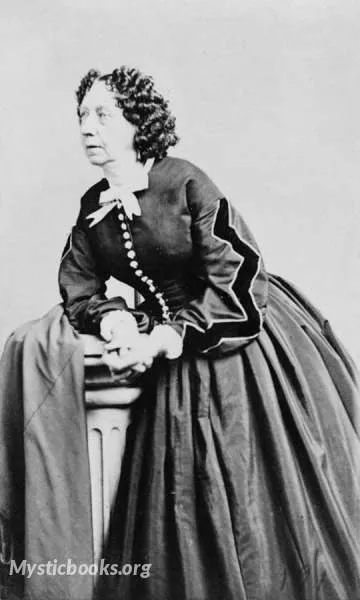
Timeline
Title
Country/Nationality
Fanny Fern
Fanny Fern, was an American novelist, children's writer, humorist, and newspaper columnist in the 1850s to 1870s. Her popularity has been attributed to a conversational style and sense of what mattered to her mostly middle-class female readers. By 1855, Fern was the highest-paid US columnist, commanding $100 per week for her New York Ledger column. A collection of her columns published in 1853 sold 70,000 copies in its first year. Her best-known work, the fictional autobiography Ruth Hall (1854), has become a popular subject among feminist literary scholars.
Sara Payson Willis was born in Portland, Maine, to newspaper owner Nathaniel Willis and Hannah Parker. Willis attended Catharine Beecher's boarding school in Hartford, Connecticut. Beecher later described her as one of her "worst-behaved girls" (adding that she also "loved her the best.") Here, the girl had her first taste of literary success when her compositions were published in the local newspaper. She also attended the Saugus Female Seminary. After returning home, Willis wrote and edited articles for her father's Christian newspapers, The Puritan Recorder and The Youth's Companion.
In 1837, she married Charles Harrington Eldredge, a banker, and they had three daughters: Mary Stace (1838), Grace Harrington (1841), and Ellen Willis (1844). Her mother and younger sister Ellen both died early in 1844; in 1845 her eldest daughter Mary died of brain fever (meningitis); soon afterward, her husband Charles succumbed to typhoid fever.
Willis was left nearly destitute. With little help from either her father or her in-laws – and none from her brother N.P. Willis – she struggled to make ends meet for her surviving young daughters. Her father persuaded her to remarry.
In December 1848 the young widow married Samuel P. Farrington, a merchant. The marriage was a mistake. Farrington was so intensely jealous that in 1851 Willis left him, scandalizing her family, and they divorced two years later.
Willis published her first article, "The Governess", in November 1851 in the new Boston newspaper Olive Branch, followed by some short satirical pieces there and in True Flag; soon after she regularly began using the pen name "Fanny Fern" for all her articles. In 1852, on her own with two daughters to support, she began writing in earnest. She sent samples of her work under her own name to her brother Nathaniel, by then a magazine owner, but he refused them and said her writing was not marketable outside Boston. He was proved wrong, as newspapers and periodicals in New York and elsewhere began printing Fanny Fern's "witty and irreverent columns".
In the summer of 1852, Fern was hired by the publisher Oliver Dyer at twice her salary to publish a regular column exclusively in his New York newspaper Musical World and Times; she was the first woman to have a regular column. The next year, Dyer helped her find a publisher for her first two books: Fern Leaves from Fanny's Portfolio (1853), a selection of her more sentimental columns, and Little Ferns for Fanny's Little Friends (1853), a children's book. She had to reveal her legal name to the publishers. As it was then still Farrington and disagreeable to her, she tried to keep her name secret. The former book sold 70,000 copies in its first year, "a phenomenal figure for the time."
James Parton, a biographer and historian who edited Home Journal, the magazine owned by Fern's brother Nathaniel (known as N.P. Willis), was impressed by Fern's work. He published her columns and invited the author to New York City. When her brother discovered this, he forbade Parton from publishing any more of Fern's work. Instead Parton resigned as editor of the magazine in protest.
Fern's first book, Fern Leaves (1853), was a best seller. It sold 46,000 copies in the first four months, and over 70,000 copies the first year. She received ten cents a copy in royalties, enough for her to buy a house in Brooklyn and live comfortably. Three years into her career, in 1855 she was earning $100 a week for her column in the New York Ledger, making her the highest-paid columnist in the United States. Her first regular column appeared on January 5, 1856, and would run weekly, without exception, until October 12, 1872, when the last edition was printed two days after her death.
Sara Willis and James Parton were married in 1856 when she was 45 and well established. She and her husband lived in New York City with Ellen, one of her two surviving daughters. They also raised Ethel, her granddaughter and orphan of Grace, who died in 1862.
In 1859, Fern bought a brownstone in Manhattan at what is now 303 East Eighteenth Street near Second Avenue. She and Parton lived in the house for the 13 years until her death.
Fern continued as a regular columnist for the Ledger for the remainder of her life. She was a suffrage supporter, and in 1868 she co-founded Sorosis, New York City's pioneer club for women writers and artists, formed after women were excluded from hearing the author Charles Dickens at the all-male New York Press Club dinner in his honor.
Fern dealt with cancer for six years and died on October 10, 1872. She is buried in Mount Auburn Cemetery in Cambridge, Massachusetts next to her first husband. Her gravestone was inscribed simply "Fanny Fern." After her death, her widower James Parton published Fanny Fern: A Memorial Volume (1874).
Books by Fanny Fern

Ruth Hall
Ruth Hall: A Domestic Tale of the Present Time by Fanny Fern (pen name of Sara Payson Willis), a popular 19th-century newspaper writer. Following on her meteoric rise to fame as a columnist, she signed a contract in February 1854 to write a full-leng...